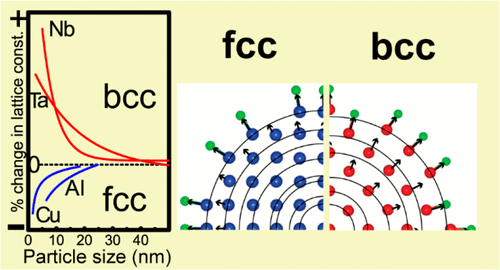Our official English website, www.x-mol.net, welcomes your
feedback! (Note: you will need to create a separate account there.)
A Reduction in Particle Size Generally Causes Body-Centered-Cubic Metals to Expand but Face-Centered-Cubic Metals to Contract
ACS Nano ( IF 15.8 ) Pub Date : 2018-06-06 00:00:00 , DOI: 10.1021/acsnano.8b03360 Dhani Nafday 1 , Subhrangsu Sarkar 2 , Pushan Ayyub 2 , Tanusri Saha-Dasgupta 1
ACS Nano ( IF 15.8 ) Pub Date : 2018-06-06 00:00:00 , DOI: 10.1021/acsnano.8b03360 Dhani Nafday 1 , Subhrangsu Sarkar 2 , Pushan Ayyub 2 , Tanusri Saha-Dasgupta 1
Affiliation

|
From a careful analysis of existing data as well as new measurements, we show that the size dependence of the lattice parameters in metal nanoparticles with face-centered cubic (fcc) and body-centered cubic (bcc) symmetries display opposite trends: nanoparticles with fcc structure generally contract with decreasing particle size, while those with bcc structure expand. We present a microscopic explanation for this apparently puzzling behavior based on first-principles simulations. Our results, obtained from a comparison of density functional theory calculations with experimental data, indicate that the nanoparticles are capped by a surface monolayer of oxygen atoms, which is routinely detected by surface-sensitive techniques. The bcc- and fcc-based nanoparticles respond in contrasting fashion to the presence of the oxygen capping layer, and this dictates whether the corresponding lattice parameter would increase or decrease with size reduction. The metal–oxygen bonds at the surface, being shorter and stronger than typical metal–metal bonds, pull the surface metal atoms outward. This outward movement of surface atoms influences the core regions to a larger extent in the relatively open bcc geometry, producing a rather large overall expansion of the cluster, compared to the bulk. In case of fcc clusters, on the other hand, the outward movement of surface metal atoms does not percolate too far inside, resulting in either a smaller net expansion or contraction of the cluster depending on the extent of surface oxygen coverage. Our study therefore provides a convincing physicochemical basis for the correlation between the underlying geometry and the nature of change of the lattice parameters under size reduction.
中文翻译:

减小粒度通常会导致体心立方金属膨胀,而面心立方金属收缩
通过对现有数据的仔细分析以及新的测量结果,我们发现具有对称面心立方(fcc)和体心立方(bcc)对称的金属纳米颗粒中晶格参数的大小依赖性显示出相反的趋势:带有fcc的纳米颗粒结构通常随着粒径的减小而收缩,而具有密件抄送结构的颗粒会膨胀。我们基于第一原理模拟对此明显令人困惑的行为提供了微观解释。通过将密度泛函理论计算与实验数据进行比较而获得的结果表明,纳米粒子被氧原子的表面单层覆盖,这通常是通过表面敏感技术检测到的。基于bcc和fcc的纳米颗粒对氧气覆盖层的存在形成了鲜明的对比,这决定了相应的晶格参数是随着尺寸减小而增加还是减小。表面的金属-氧键比典型的金属-金属键短和强,将表面的金属原子向外拉。表面原子的这种向外移动在相对开放的密件抄送几何结构中在更大程度上影响了核心区域,与团簇相比,产生了相当大的簇整体膨胀。另一方面,在fcc簇的情况下,表面金属原子的向外移动不会渗透到内部太远,从而导致簇的较小净膨胀或收缩,具体取决于表面氧覆盖的程度。
更新日期:2018-06-06
中文翻译:

减小粒度通常会导致体心立方金属膨胀,而面心立方金属收缩
通过对现有数据的仔细分析以及新的测量结果,我们发现具有对称面心立方(fcc)和体心立方(bcc)对称的金属纳米颗粒中晶格参数的大小依赖性显示出相反的趋势:带有fcc的纳米颗粒结构通常随着粒径的减小而收缩,而具有密件抄送结构的颗粒会膨胀。我们基于第一原理模拟对此明显令人困惑的行为提供了微观解释。通过将密度泛函理论计算与实验数据进行比较而获得的结果表明,纳米粒子被氧原子的表面单层覆盖,这通常是通过表面敏感技术检测到的。基于bcc和fcc的纳米颗粒对氧气覆盖层的存在形成了鲜明的对比,这决定了相应的晶格参数是随着尺寸减小而增加还是减小。表面的金属-氧键比典型的金属-金属键短和强,将表面的金属原子向外拉。表面原子的这种向外移动在相对开放的密件抄送几何结构中在更大程度上影响了核心区域,与团簇相比,产生了相当大的簇整体膨胀。另一方面,在fcc簇的情况下,表面金属原子的向外移动不会渗透到内部太远,从而导致簇的较小净膨胀或收缩,具体取决于表面氧覆盖的程度。









































 京公网安备 11010802027423号
京公网安备 11010802027423号